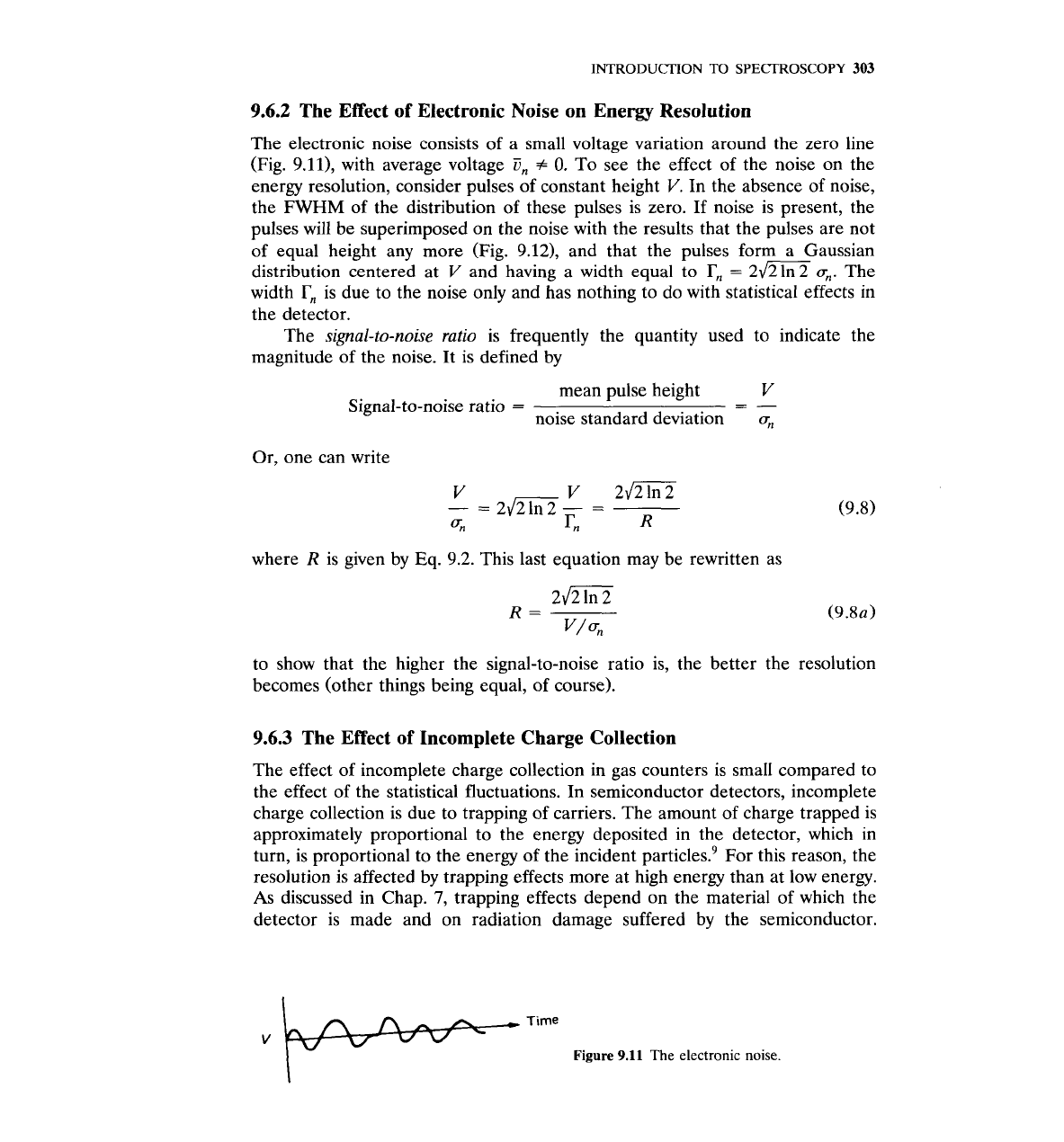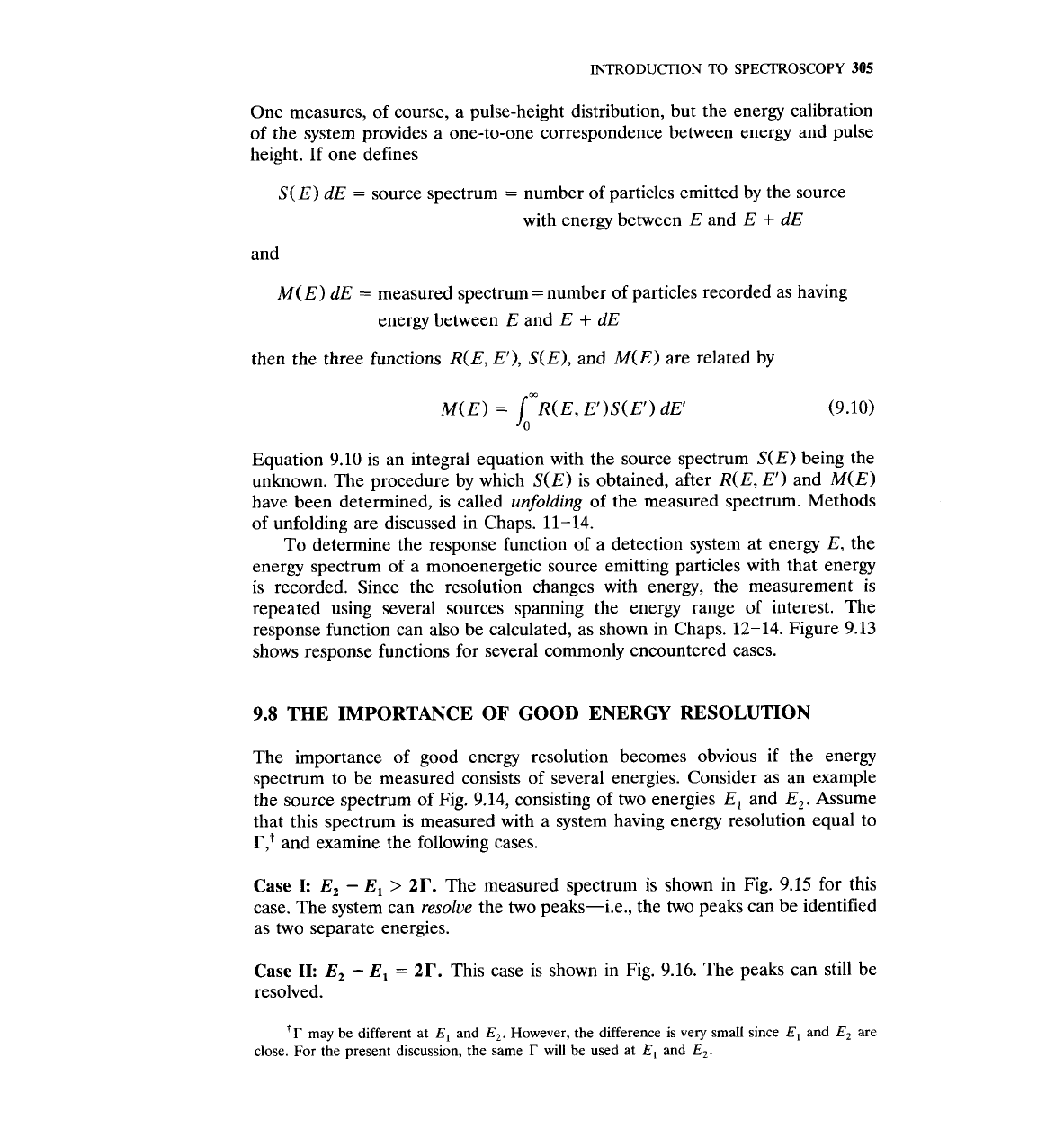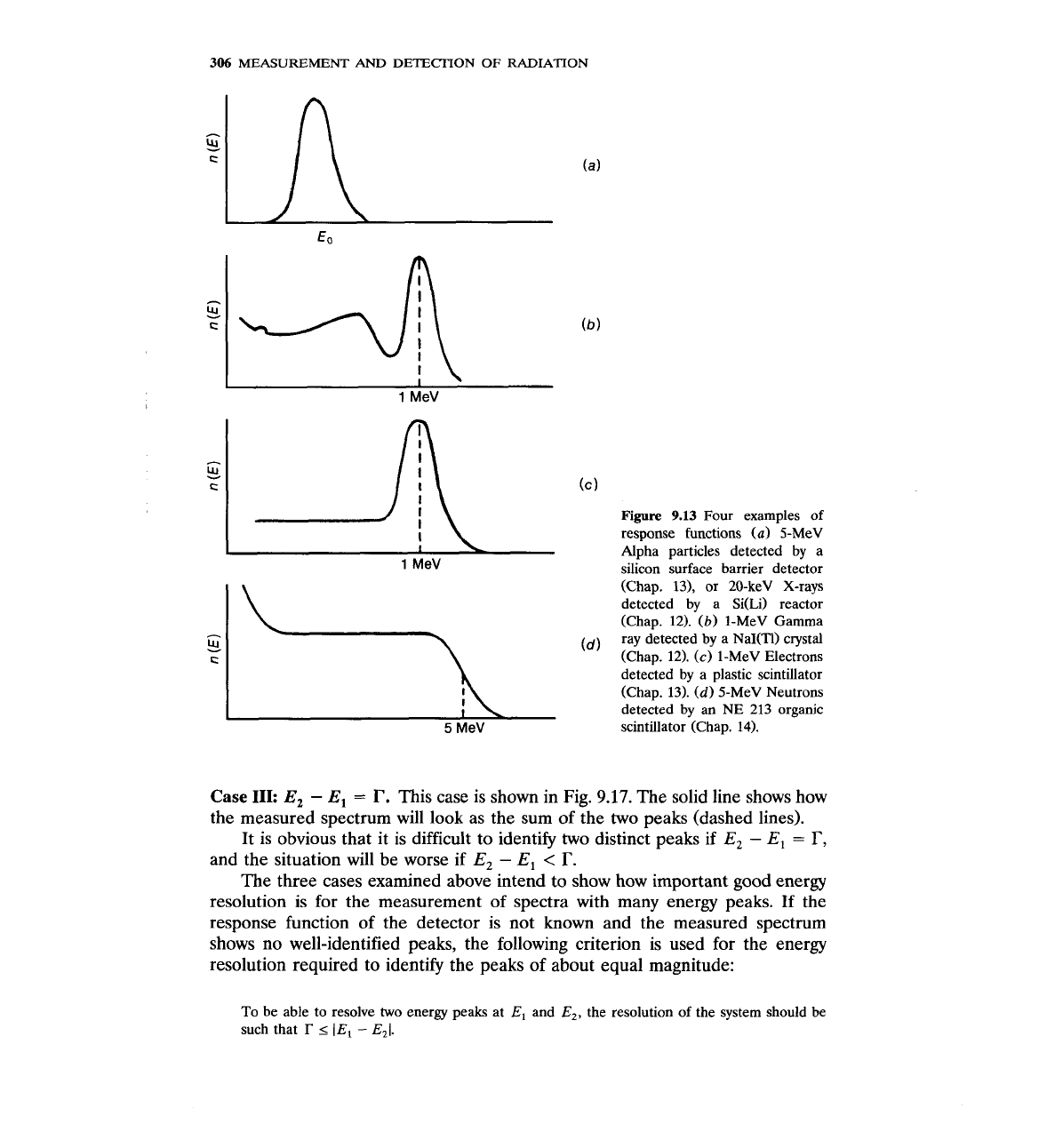Tsoulfanidis N. Measurement and detection of radiation
Подождите немного. Документ загружается.


298
MEASUREMENT
AND
DETECTION
OF
RADIATION
1
I I
I
IIII
Ill
v,
v,
v6
v5
v4
v3
v2
v1
1
Figure
9.7
The integral spec-
Discriminator
level
trum corresponding to the pulse
spectrum of Fig.
9.6.
4
"0
where
I/,
are the successive settings of the lower threshold of the
SCA.
It is
important to note that one never measures the value of
n(V),
but only the
product
n(V) AV.
9.5
THE RELATIONSHIP BETWEEN PULSE-HEIGHT
DISTRIBUTION
AND
ENERGY SPECTRUM
To determine the energy spectrum of particles emitted
by
a
source, one
measures, with the help of a detector and appropriate electronics, the pulse-
Table
9.2
Measurement
of
Differential Spectrum
SCA
threshold
n(v)
AV
I
I1
vi
v,
"5
~4~3
v,
v,
Figure
9.8
A
differential en-
Lower threshold of the
SCA
I
vo
ergy spectrum measured with
an
SCA.

INTRODUCTION
TO
SPECTROSCOPY
299
height distribution produced by these particles. Fundamental requirements for
the detector and the electronics are as follows:
1.
The particle should deposit all its energy or a known constant fraction of it in
the detector.
2.
The voltage pulse produced by the detector should be proportional to the
particles energy dissipated in it, or a known relationship should exist between
energy dissipated and pulse height.
3.
The electronic amplification should be the same for all pulse heights.
Since the relationship between pulse-height distribution and energy spectrum
depends on these three requirements, it is important to discuss them in some
detail.
Charged particles deposit all their energy in the detector, as long as their
range is shorter than the size of the detector. Gammas do not necessarily
deposit all their energy in the detector, regardless of detector size. Neutrons are
detected indirectly through other particles produced by nuclear reactions. The
energy deposited in the detector depends not only on the energy of the neutron
but also on the energy and type of the reaction products.
The events that transform the particle energy into a voltage pulse are
statistical in nature.
As
a result, even if all the particles deposit exactly the same
energy in the detector, the output pulses will not be the same but they will have
a certain distribution.
The state of commercial electronics is such that the amplification is essen-
tially the same for all pulse heights (see also
Sec. 10.11).
As a result of incomplete energy deposition and the statistical nature of the
events that take place in the detector, the shape of the pulse-height distribution
is different from that of the source energy spectrum. In other words, two spectra
are involved in every measurement:
1.
The source spectrum: This is the energy spectrum of particles emitted by the
source.
2.
The measured spectrum: This is the measured pulse height distribution.
Consider, for example, the measured pulse-height distribution shown in Fig.
9.9b produced by a monoenergetic gamma source. This distribution (or spec-
trum) is obtained using a scintillation counter. The observer records the data
shown in Fig.
9.9b, which is not identical to that of the source, Fig. 9.9~. The
objective of the measurement is to obtain the spectrum of Fig.
9.9a, but the
observer actually measures the distribution shown by Fig.
9.96.
The task of the
observer is, therefore, to apply appropriate corrections to the measured spec-
trum to finally obtain the source spectrum.

300
MEASUREMENT
AND
DETECTION
OF
RADIATION
9.6
ENERGY RESOLUTION OF
A
DETECTION SYSTEM
The quality of the performance of a detection system used for energy measure-
ments is characterized by the width of the pulse-height distribution obtained
with particles of the same energy (monoenergetic source). Even in the case
where each particle deposits exactly the same energy in the detector, the
pulse-height distribution will not be a single line (like that shown in Fig.
9.9~);
instead, it will have a certain finite width (Fig.
9.10)
due to
1.
Statistical fluctuations in the number of charge carriers produced in the
detector
2. Electronic noise in detector itself, the preamplifier, and the amplifier
3.
Incomplete collection of the charge produced in the detector
The
width,
measured at half of the maximum of the bell-shaped curve, is
indicated by
r
or by full width at half maximum (FWHM). The ability of a
detector to identify particles of different energies, called the
energy resolution,
is
given either in terms of
r
or in terms of the ratio R(E,), where
r
R(Eo)
=
-
(9.2)
Eo
The width
r
is given in energy units, while the ratio R(Eo) is given as a
percentage.
Figure
9.9
(a)
The source energy spectrum
of a monoenergetic gamma source.
(b)
The
pulse-height distribution obtained with
a
NaI(T1) scintillation counter.

INTRODUCTION
TO
SPECTROSCOPY
301
Source
spectrum
distribution
Figure
9.10
The energy resolution of the detector is given
by
the width
r
or the ratio
T/E,,.
The most important elements affecting the energy resolution of a radiation
detection system are the three statistical factors mentioned above in relation to
the width
r.
It is worth repeating that in energy measurements it is the energy
resolution of the counting system (detector-preamplifier-amplifier) that is the
important quantity and not the energy resolution of just the detector.
9.6.1
The Effect of Statistical Fluctuations: The Fano Factor
To discuss the effect of the statistical fluctuations on energy resolution, consider
a monoenergetic source of charged particles being detected by a silicon semi-
conductor detector. (The discussion would apply to a gas-filled counter as well.)
The average energy
w
needed to produce one electron-hole pair in silicon is
3.66 eV, although the energy gap (E,) is
1.1
eV. This difference between
w
and
E,
shows that part of the energy of the incident particles is dissipated into
processes that do not generate charge carriers. Any process that consumes
energy without producing electron-hole pairs is, of course, useless to the
generation of the detector signal. If the energy deposited in the detector is E,
the average number of charge carriers is
E/w.
If
the process of the electron-hole
generation were purely statistical, Poisson statistics would apply and the stan-
dard deviation of the number of pairs would be
Experience has shown that the fluctuations are smaller than what
Eq.
9.3 gives.
The observed statistical fluctuations are expressed in terms of the
Fano factor

302
MEASUREMENT
AND
DETECTION
OF
RADIATION
F,l where
(standard deviation of the number of pairs produced)2
F=
number of pairs produced
or, using Eq. 9.3,
The two extreme values of
F
are 0 and
1.
F
=
0
means that there are no statistical fluctuations in the number of pairs
produced. That would be the case if all the energy was used for production of
charge carriers.
F
=
1
means that the number of pairs produced is governed by
Poisson statistics.
Fano factors have been calculated and also measured.'-' For semiconduc-
tor detectors,
F
values as low as 0.06 have been rep~rted.~ For gas-filled
counters, reported
F
values lie between 0.2 and 0.5. Values of
F
<
1
mean that
the generation of electron-hole pairs does not exactly follow Poisson statistics.
Since Poisson statistics applies to outcomes that are independent, it seems that
the ionization events in a counter are interdependent.
The width
r
of a Gaussian distribution, such as that shown in Fig. 9.10, is
related to the standard deviation
cr
by
Combining Eqs. 9.4 and 9.5,
Equation 9.5 shows that the width Tf, which is due to the statistical fluctuations,
is roughly proportional to the square root of the energy (the Fano factor is a
weak function of energy).
To compare the contribution of the statistical fluctuations to the resolution
of different types of detectors at a certain energy, one can use Eqs. 9.2 and 9.6
and write for detectors
1
and 2
It can be seen from Eq. 9.7 that the resolution is better for the detector with the
smaller average energy needed for the creation of a charge carrier pair (and
smaller Fano factor). Thus, the energy resolution of a semiconductor detector
(w
-
3 eV,
F
<
0.1) should be expected to be much better than the resolu-
tion of a gas-filled counter
(w
=
30 eV,
F
.=
0.2), and indeed it is (see Chaps. 12
and 13).

INTRODUCTION
TO
SPECTROSCOPY
303
9.6.2 The Effect of Electronic Noise on Energy Resolution
The electronic noise consists of a small voltage variation around the zero line
(Fig. 9.11), with average voltage
En
#
0.
To see the effect of the noise on the
energy resolution, consider pulses of constant height
V.
In the absence of noise,
the FWHM of the distribution of these pulses is zero. If noise is present, the
pulses will be superimposed on the noise with the results that the pulses are not
of equal height any more (Fig.
9.12), and that the pulses form a Gaussian
distribution centered at
V
and having a width equal to
Tn
=
2m-z
q,.
The
width
rn
is due to the noise only and has nothing to do with statistical effects in
the detector.
The
signal-to-noise ratio
is frequently the quantity used to indicate the
magnitude of the noise. It is defined by
mean pulse height
V
Signal-to-noise ratio
=
=
-
noise standard deviation
an
Or, one can write
where
R
is given by Eq. 9.2. This last equation may be rewritten as
to show that the higher the signal-to-noise ratio is, the better the resolution
becomes (other things being equal, of course).
9.6.3 The Effect of Incomplete Charge Collection
The effect of incomplete charge collection in gas counters is small compared to
the effect of the statistical fluctuations. In semiconductor detectors, incomplete
charge collection is due to trapping of carriers. The amount of charge trapped is
approximately proportional to the energy deposited in the detector, which in
turn, is proportional to the energy of the incident
particle^.^
For this reason, the
resolution is affected by trapping effects more at high energy than at low energy.
As discussed in Chap.
7,
trapping effects depend on the material of which the
detector is made and on radiation damage suffered by the semiconductor.

304
MEASUREMENT AND DETECITON OF
RADIATION
Figure
9.12
(a)
The pulses are superimposed on the noise, as a result of which
(b)
they show a
distribution with a width that depends on the standard deviation of the noise.
Usually, the effect of incomplete charge collection is included in the statistical
fluctuations.
9.6.4
The Total Width
r
The total width
r
(or the total energy resolution) is obtained by adding in
quadrature the contributions from the statistical effects
(r')
and from the noise
and incomplete charge collection (T,). Thus,
For gas and scintillator counters, the main contribution comes from the statisti-
cal fluctuations. For semiconductor detectors at low energies, measurements
have shown that T,
>
rf.
At higher energies this is reversed, since
T,
is
essentially independent of energy while
I'f
increases with it (see Eq. 9.6).
9.7
DETERMINATION OF THE ENERGY RESOLUTION-THE
RESPONSE FUNCTION
Depending on the type and energy of the incident particle and the type of the
detector, a monoenergetic source produces a pulse-height distribution that may
be a Gaussian (Fig.
9.10)
or a more complicated function (Fig. 9.9). In either
case, one concludes that although all the particles start at the source with the
same energy, there is a probability that they may be recorded within a range of
energies. That probability is given by the
response function
or
energy resolution
function
R(E,
E')
of the detection system, defined as
R(E, E') dE
=
probability that a particle emitted by the source with energy E'
will be recorded with energy between E and
E
+
dE

INTRODUCTION
TO
SPECTROSCOPY
305
One measures, of course, a pulse-height distribution, but the energy calibration
of the system provides a one-to-one correspondence between energy and pulse
height. If one defines
S( E)
dE
=
source spectrum
=
number of particles emitted by the source
with energy between
E
and
E
+
dE
and
M(
E)
dE
=
measured spectrum
=
number of particles recorded as having
energy between
E
and
E
+
dE
then the three functions
R(E, E'), S(E),
and
M(E)
are related
by
Equation 9.10 is an integral equation with the source spectrum
S(E)
being the
unknown. The procedure by which
S(E)
is obtained, after
R(E, E')
and
M(E)
have been determined, is called
unfolding
of the measured spectrum. Methods
of unfolding are discussed in Chaps. 11-14.
To determine the response function of a detection system at energy
E,
the
energy spectrum of a monoenergetic source emitting particles with that energy
is recorded. Since the resolution changes with energy, the measurement is
repeated using several sources spanning the energy range of interest. The
response function can also be calculated, as shown in Chaps. 12-14. Figure 9.13
shows response functions for several commonly encountered cases.
9.8
THE
IMPORTANCE OF GOOD ENERGY RESOLUTION
The importance of good energy resolution becomes obvious if the energy
spectrum to be measured consists of several energies. Consider as an example
the source spectrum of Fig. 9.14, consisting of two energies
E,
and
E,.
Assume
that this spectrum is measured with a system having energy resolution equal to
I',+
and examine the following cases.
Case
I:
E,
-
El
>
2r'.
The measured spectrum is shown in Fig. 9.15 for this
case. The system can
resolve
the two peaks-i.e., the two peaks can be identified
as two separate energies.
Case
11:
E,
-
E,
=
2I'.
This case is shown in
Fig.
9.16. The peaks can still be
resolved.
'T
may be different at
El
and
E,.
However, the difference is very small since
El
and
E,
are
close. For the present discussion, the same
will be used at
El
and
E,.

306
MEASUREMENT
AND
DETECITON
OF
RADIATION
Figure
9.13
Four examples of
response functions
(a)
5-MeV
Alpha particles detected by a
silicon surface barrier detector
(Chap. 13), or 20-keV X-rays
detected by a Si(Li) reactor
(Chap. 12).
(b)
1-MeV Gamma
ray detected by a NaI(TI) crystal
(Chap. 12).
(c)
1-MeV Electrons
detected by a plastic scintillator
(Chap. 13).
(d)
5-MeV Neutrons
detected by an NE 213 organic
scintillator (Chap. 14).
Case
111:
E,
-
E,
=
r.
This case is shown in Fig.
9.17.
The solid line shows how
the measured spectrum will look as the sum of the two peaks (dashed lines).
It is obvious that it is difficult to identify two distinct peaks if
E,
-
El
=
T,
and the situation will be worse if
E,
-
E,
<
T.
The three cases examined above intend to show how important good energy
resolution is for the measurement of spectra with many energy peaks. If the
response function of the detector is not known and the measured spectrum
shows no well-identified peaks, the following criterion is used for the energy
resolution required to identify the peaks of about equal magnitude:
To be able to resolve two energy peaks at
El
and
E,,
the resolution of the system should be
such that
r
I
(El
-
E,I.

INTRODUCTION TO SPECTROSCOPY
307
L
E2
E
Figure
two distinct
9.14
energies. Source spectrum consisting
of
9.9
BRIEF DESCRIPTION OF
A
MULTICHANNEL
ANALYZER (MCA)
To measure an energy spectrum of a radioactive source means to record the
pulse-height distribution produced by the particles emitted from the source,
which is achieved with the use of an instrument called the multichannel analyzer
(MCA). Multichannel analyzers are used in either of two different modes: the
pulse-height analysis
(PHA) mode or the
multichannel scaling
(MCS) mode.
The MCS mode is used to count events as a function of time. The individual
channels of the memory count all incoming pulses for a preset time width
At.
After time
At,
the counting operation is switched automatically to the next
channel in the memory, thus producing in the end a time sequence of the
radiation being detected. For example, if the radiation source is a short-lived
isotope, the MCS mode will provide the exponential decay curve that can be
used for the measurement of the half-life of this isotope. The MCS mode is also
useful for Mossbauer experiments.
The PHA mode is the traditional function of an MCA and is used to sort
out incoming pulses according to their height and store the number of pulses of
a particular height in a corresponding address of the MCA memory called the
channel number.
In the PHA mode, an MCA performs the function of
a
series of SCAs
placed adjacent to one another. When only one SCA with width
AE
is used, the
experimenter has to sweep the spectrum by moving the lower threshold of the
SCA manually (see Sec.
9.4).
On the other hand, if one had many SCAs, all
counting simultaneously, the whole spectrum would be recorded simultaneously.
